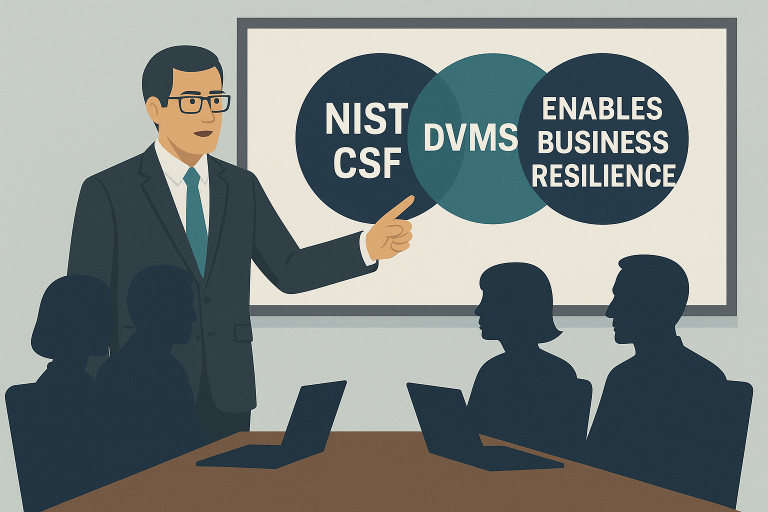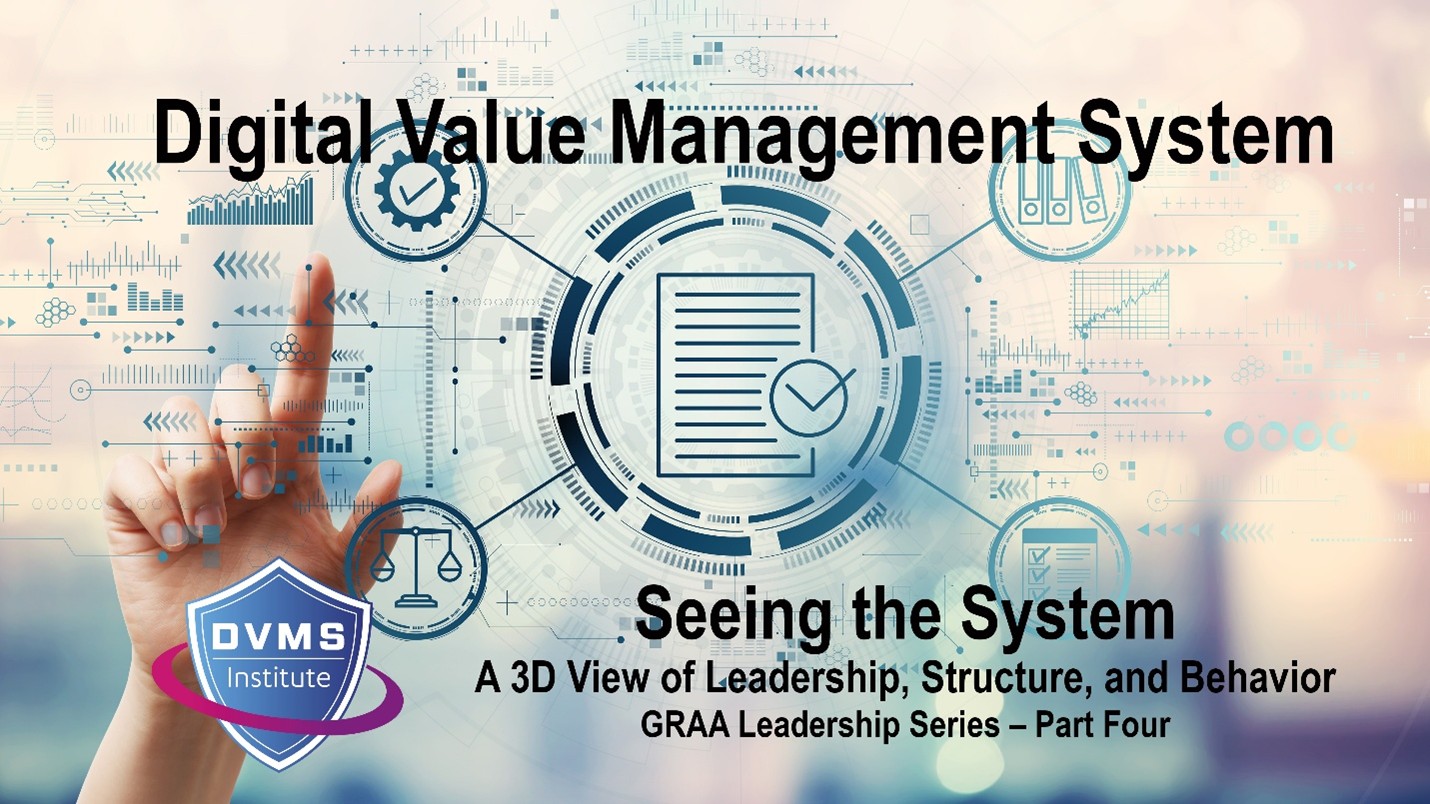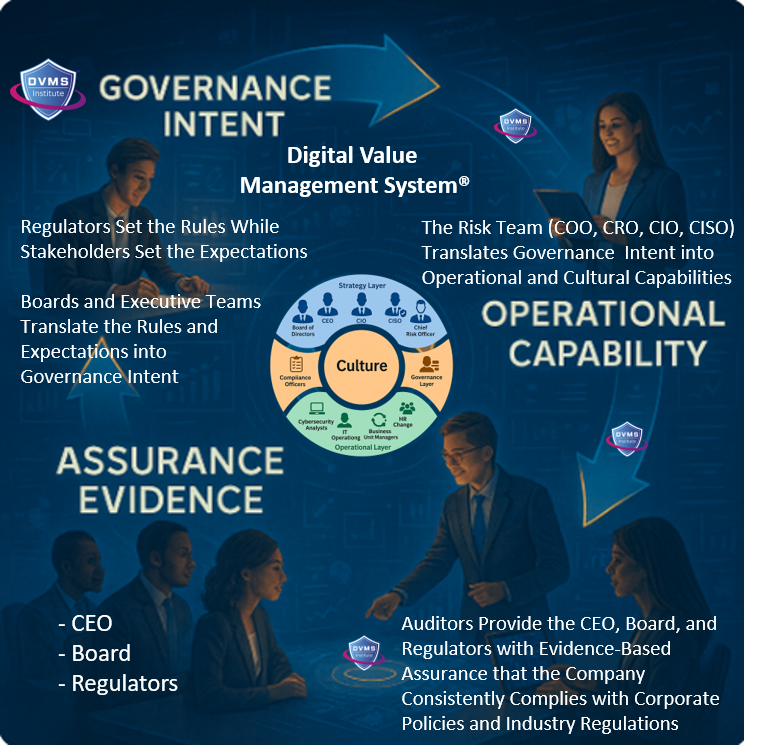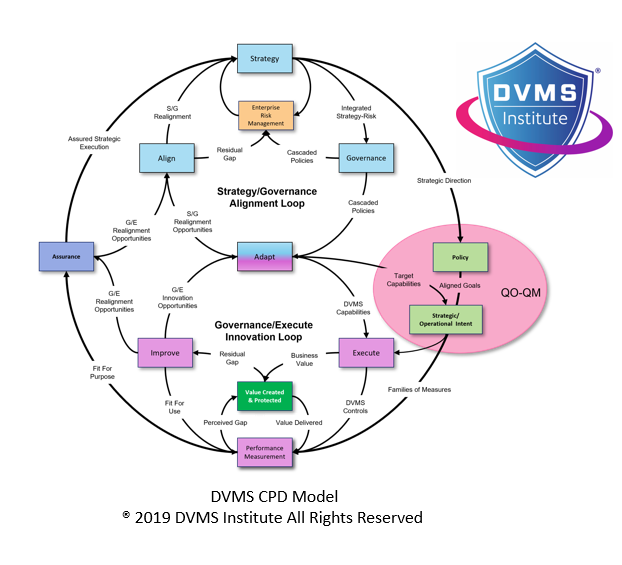How CISOs can Earn a Seat in the Boardroom Using a NIST Cybersecurity Framework Digital Value Management System
Rick Lemieux – Co-Founder and Chief Product Officer of the DVMS Institute
Introduction: The CISO’s Strategic Dilemma
Chief Information Security Officers (CISOs) stand at a critical juncture in an era marked by escalating digital threats and intensifying regulatory pressures. Their role has evolved beyond technical oversight to become a key enabler of business resilience and value creation. Yet, many CISOs struggle to secure a strategic voice in boardrooms. A transformative path forward lies in aligning cybersecurity with enterprise governance and business outcomes, made possible through the DVMS Institute’s NIST Cybersecurity Framework (CSF) 2.0 Digital Value Management System® (DVMS). This unique and innovative approach to organizational cyber resilience empowers CISOs to transition from operational defenders to strategic advisors who shape digital business resiliency and success.
From Technical Execution to Strategic Governance
Traditional approaches often silo cybersecurity within IT, isolating it from broader business strategy. As outlined in the Institute’s Practitioner’s Guide to NIST-CSF, this perception has become a barrier to effective digital risk governance. The DVMS and CSF 2.0 redefine cybersecurity as a business risk issue, rooted in enterprise risk management (ERM) rather than technical compliance alone
CSF 2.0, particularly with its addition of the GOVERN Function, embeds cybersecurity directly into the fabric of corporate governance. This Function calls for clear roles and responsibilities and the integration of cybersecurity into broader ERM frameworks. For the CISO, this provides a language and structure to engage board-level stakeholders in meaningful, risk-based conversations.
Value Creation and Protection: The CISO’s New Mandate
The DVMS CPD Model—Create, Protect, Deliver—offers a paradigm shift. It views cybersecurity as an enabler of digital business value, not merely a safeguard against threats. The model positions CISOs as stewards of digital trust by embedding protection into the value creation lifecycle.
This dual focus allows CISOs to move beyond asking “What are we securing?” to “How are we enabling secure digital growth?” This is the boardroom language—strategic, risk-informed, and value-driven.
Boards care deeply about resilience, continuity, brand reputation, and fiduciary duty. The CSF and DVMS empower CISOs to frame security investments as strategic enablers, not cost centers. The Practitioner’s Guide underscores this by advocating a system-based view where value creation and protection are inseparable, elevating the CISO from operational overseer to strategic architect.
Organizational Profiles and Tiers: Strategic Storytelling for the Board
A key CSF 2.0 tool for board engagement is the Organizational Profile, which provides a structured way to articulate the current and target cybersecurity posture. Profiles allow CISOs to frame gaps and improvements in business outcomes, rather than just technical maturity.
When combined with the CSF Tiers, which describe the sophistication of governance and risk management practices, CISOs gain a compelling narrative for the board. Moving from Tier 2 (Risk-Informed) to Tier 3 (Repeatable) or Tier 4 (Adaptive) is not about technical excellence alone—it reflects an organization’s increasing capacity to absorb, adapt, and thrive amid digital disruption.
This alignment enables CISOs to present cybersecurity in the same format as financial, operational, and compliance risks, making it easier for boards to evaluate and prioritize investment.
Culture, Accountability, and the CISO’s Strategic Leverage
One of the most profound insights from the Institute’s publication Thriving on the Edge of Chaos is that culture is strategy. The DVMS emphasizes that cultural change must be driven from the top, particularly around digital risk. In this context, CISOs who master the language of organizational behavior, governance, and systems thinking are better equipped to shape enterprise-wide security mindsets.
The DVMS Z-X Model identifies seven Minimum Viable Capabilities (Govern, Assure, Plan, Design, Change, Execute, Innovate) that serve as a universal map for aligning cybersecurity initiatives to enterprise performance. This provides CISOs with a framework to coordinate cross-functional accountability and demonstrate how security efforts support broader business initiatives.
By engaging with governance structures, modeling accountability, and influencing cultural change, CISOs demonstrate their strategic value and readiness to participate at the highest levels of leadership.
Cyber Resilience: A Board-Level Imperative
Cybersecurity incidents are no longer mere operational disruptions—they are existential threats. The IBM 2022 Cost of a Data Breach Report places the average breach cost at $4.4 million. For boards, this is a financial risk, a reputational risk, and increasingly, a compliance and liability risk.
CSF 2.0 helps CISOs translate this reality into board-friendly language. Its emphasis on outcomes over controls and integration with global standards and sector-specific references allows for tailored risk reporting. Meanwhile, the DVMS FastTrack™ approach provides a phased path to maturity, enabling CISOs to show measurable progress in stabilization, optimization, and innovation.
This aligns with what boards want: actionable roadmaps, KPIs tied to strategy, and evidence of continuous improvement.
Enabling Strategic Conversations with QO-QM and the 3D Knowledge Model
CISOs often struggle to communicate complex security concepts in strategic terms. DVMS addresses this through models like Question Outcome–Question Metric (QO-QM) and the 3D Knowledge Model, which link team knowledge, collaboration, and strategic alignment.
QO-QM helps CISOs frame questions that reveal systemic risks, identify measurement strategies, and clarify assumptions. The 3D Knowledge Model enables CISOs to show how security initiatives intersect with team behavior (including that of third-party suppliers) and business strategy, turning abstract risk into concrete, measurable outcomes. This strengthens the CISO’s credibility and relevance in boardroom discussions.
Conclusion: Earning and Owning the Seat
The path to the boardroom isn’t paved with technical reports or compliance checklists. It’s earned by aligning security with business outcomes, framing risk as a strategic driver, and demonstrating cultural leadership. The NIST CSF 2.0 and DVMS together give CISOs the language, structure, and insight needed to make this shift.
By adopting the CSF and DVMS approach, CISOs evolve from technologists to value architects—leaders who create resilient organizations and secure the trust of stakeholders. In doing so, they don’t just earn a seat at the table—they help define what the table looks like.
About the Author

Rick Lemieux
Co-Founder and Chief Product Officer of the DVMS Institute
Rick has 40+ years of passion and experience creating solutions to give organizations a competitive edge in their service markets. In 2015, Rick was identified as one of the top five IT Entrepreneurs in the State of Rhode Island by the TECH 10 awards for developing innovative training and mentoring solutions for boards, senior executives, and operational stakeholders.
The DVMS Institute’s NIST Cybersecurity Framework Digital Value Management System® certified training programs teach Internal or 3rd Party Digital Service Providers the skills to build a Holistic, Adaptive, and Culture-Powered Overlay System for Cyber Operational Resilience.
The NIST-CSF-DVMS positions cyber resilience not as a technical function but a strategic, enterprise-wide capability that mandates engagement from top Leadership to Frontline Employees, trained to proactively identify, classify, and mitigate the systemic cyber risks that impact digital business operations.
Enabling organizational resilience requires a coordinated effort across an organization’s Strategy, Governance, and Operational business layers. When each layer is aligned and operating cohesively as an integrated system, service providers can proactively protect their cyber assets and ensure continuity of digital business operations.
This unique and innovative approach to Adaptive Governance, Resilience, and Assurance (GRA) also enables service providers to comply with any government-mandated cyber regulation (SEC, DORA, NIS2 etc.) or maturity model program (SCF, HITRUST, CMMC etc.).
® DVMS Institute 2025 All Rights Reserved




